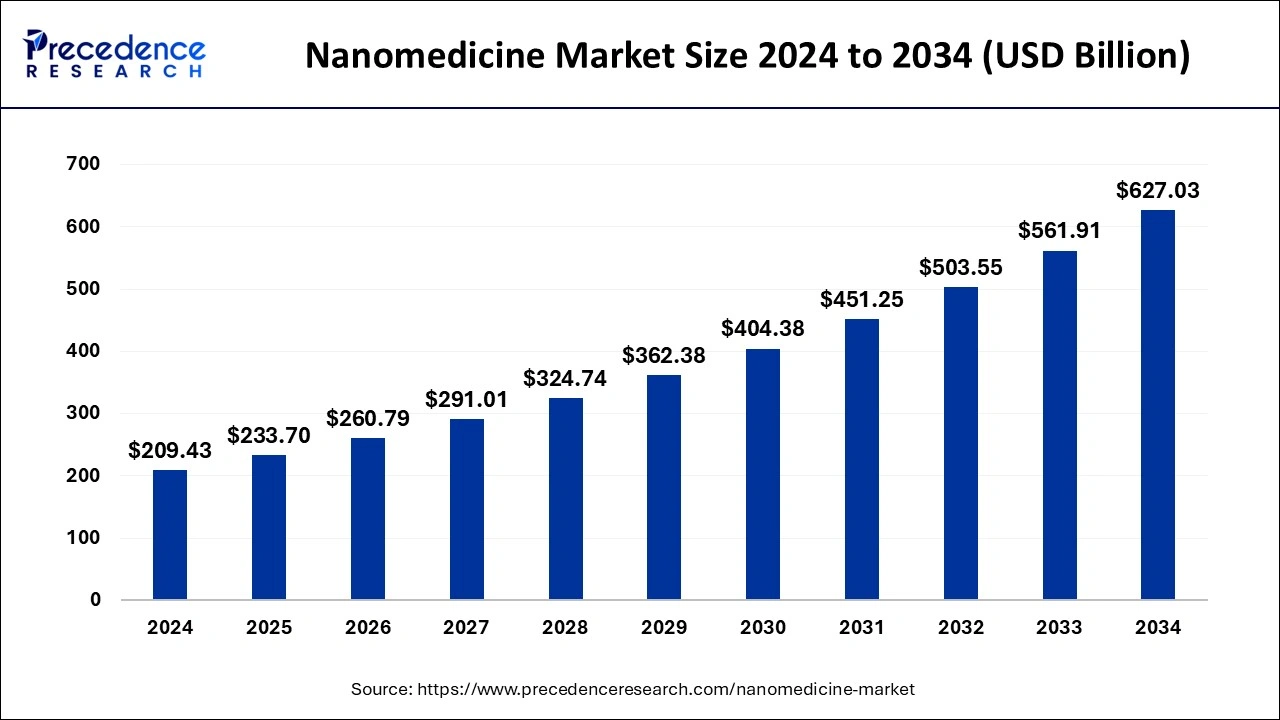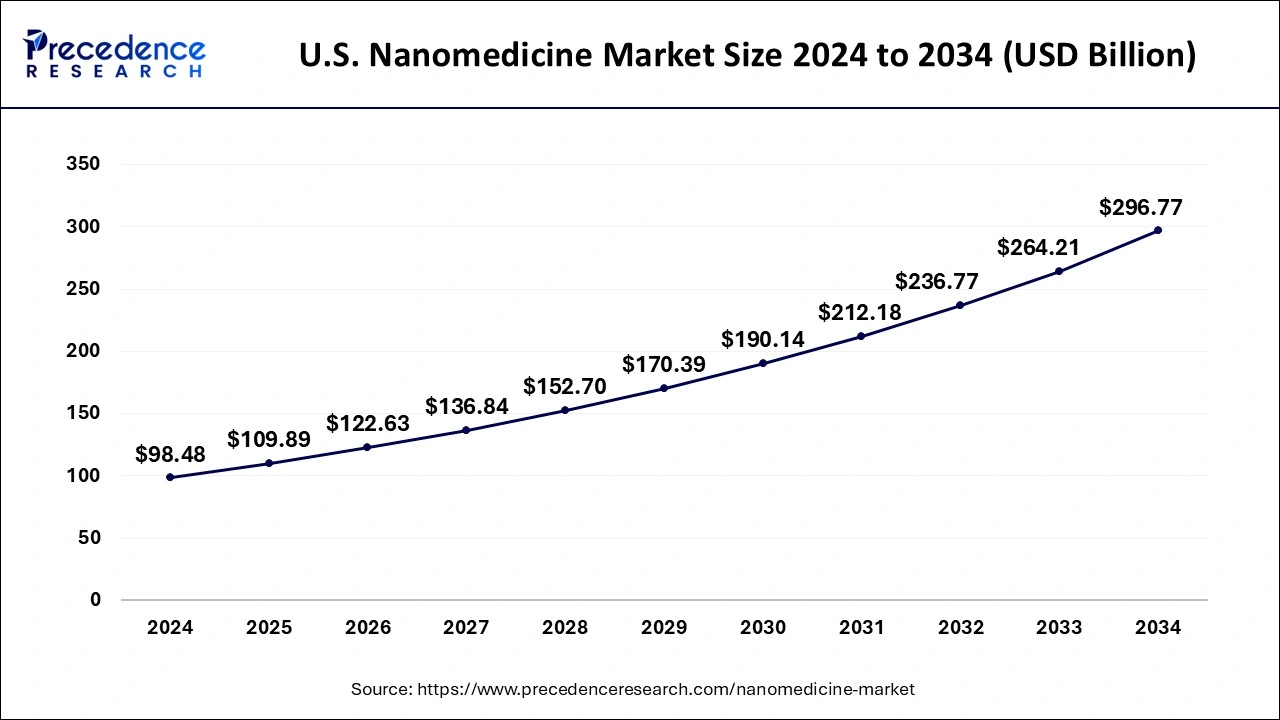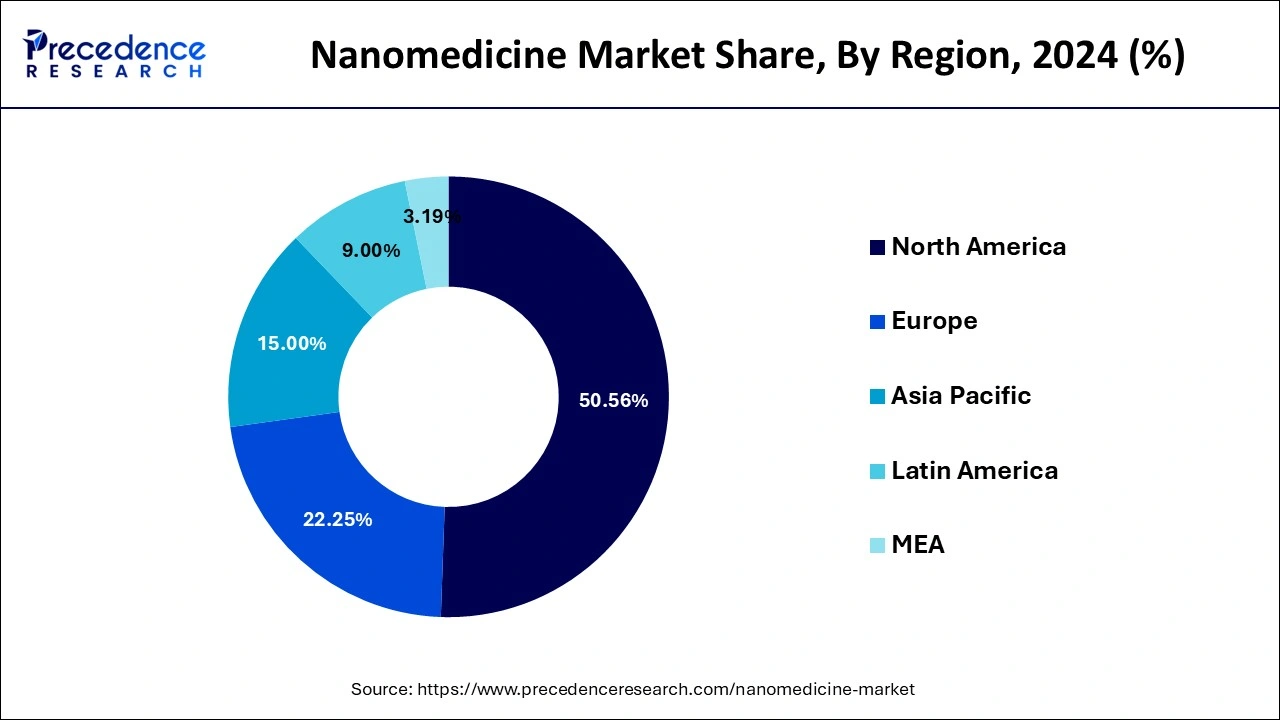List of Contents
What is the Nanomedicine Market Size?
The global nanomedicine market size was estimated at USD 209.43 billion in 2024 and is anticipated to reach around USD 627.03 billion by 2034, expanding at a CAGR of 11.59% from 2025 to 2034.

Nanomedicine Market Key Takeaways
- North America led the global nanomedicine market with the largest market share of 50.56% in 2024.
- By application, the regenerative medicine segment has held the largest market share in 2024.
- By indication, the cardiovascular diseases segment captured the biggest revenue share in 2024.
Impact of Artificial Intelligence (AI) on the Nanomedicine Market
Nanomedicine design also benefits from the use of AI to improve the quality of the product as it predicts interactions with drugs, biological fluids, the immune system, the vascular system, and cell membranes, all of which affect health. The high level of heterogeneity in tumors and between patients makes rational design of diagnostic and therapeutic platforms and analysis of their outcomes quite challenging. Integration of AI can fill this gap by using analytical models and classification algorithms to improve the accuracy of diagnosis and treatment. AI algorithms used to classify patients, screen patients for appropriate drug use, and optimize nanomedicine products have proven their value in precision medicine. AI is also used in engineered nanomedicine to optimize properties based on interactions with drug targets, biological fluids, immune systems, and cell membranes, leading to the growth of the nanomedicine market.
U.S. Nanomedicine Market Size and Growth 2025 to 2034
The U.S. nanomedicine market size was evaluated at USD 98.48 billion in 2024 and is predicted to be worth around USD 296.77 billion by 2034, rising at a CAGR of 11.66% from 2025 to 2034.

North America led the global nanomedicine market with the largest market share of 50.56% in 2024.The technological advancements combined with relevant applications in early disease diagnosis, prevention, and prophylactic of acute and chronic disorders are expected to drive the nanomedicine market growth in the U.S.
- In February 2024, The Canadian federal and provincial governments invested more than $640 million in nanotechnology research over the past decade.
Asia-Pacific, on the other hand, is expected to develop at the fastest rate during the forecast period. Various research and development efforts are also now occurring in the region on pharmaceuticals and diagnostics based on nanotechnology, which may fuel the nanomedicine market expansion.
The government-led nanotechnology initiative is coordinated by the Department of Science and Technology (DST)'s Nanoscience and Technology Mission (NanoMission) for Asia-Pacific.

Market Overview
The use of nanotechnology-based contrast reagents for diagnosis and monitoring of pharmacological effects on an unprecedentedly short timescale is also expected to fuel future growth. The demand is also expected to be influenced by the demand for biodegradable implants with extended lifespans that allow for tissue repair. Nano formulations with triggered release for tailored pharmacokinetics, nano-substances for the tumor management coupled with the radiation and nanoparticles that functions for targeted in-vivo stimulation of the cell production are expected to drive research and development in the future years.
The rising out licensing of nano medicines and the expansion of healthcare facilities in emerging markets are helping to create a market growth potential. The technological improvements such as applications in early illness diagnosis, prevention of acute and chronic ailments, and preventive intervention are likely to drive the nanomedicine market expansion. The nanotechnology entails a number of steps. The nanotechnology is the miniaturization of bigger structures and molecules on a nanometric scale, which has influenced the technology's adoption.
The worldwide nanomedicine market is likely to be driven by the increasing applications of nanomedicine as a result of technological developments in nanotechnology. There has been a boom in research activity in the field of nanotechnology, both by governments and private institutions as well as in the experimental use of this technology to cure a number of chronic diseases. This, together with the nanomedicine market's high unsatisfied medical needs, large geriatric population, and rising incidence of chronic and acute disorders is expected to give it a major boost to the nanomedicine market.
The increased global burden of chronic and infectious disorders is driving the global nanomedicine market. Cancer is the second largest cause of death worldwide, according to the World Health Organization, responsible for more than 9.5 million deaths in 2018. The nanomedicine's ability to control lymphoid and myeloid cell activity as well as improve anticancer immunity and immunotherapy efficacy will boost its use in cancer treatment. Furthermore, the opening of a NanoTherm treatment facility is likely to help the business to flourish.
Thus, the rising prevalence of genetic and cardiovascular illnesses, increasing breakthroughs in nanoscale technologies for diagnostic processes and a growing preference for tailored treatments are all driving the growth of the healthcarenanotechnologyindustry. On the other hand, the nanomedicine market's expansion is hampered by severe regulatory issues and the high cost of nanoparticle assisted medicine in comparison to its traditional counterparts.
Nanomedicine Market Growth Factors
- Nanotechnology can enhance the efficacy of cancer drugs by providing highly selective drugs, responding to specific needs, and enabling controlled release, thus spurring the growth of the nanomedicine market.
- The role of nanotechnology in drug development is that it can increase the solubility of poorly soluble drugs. Conventional drugs often have difficulty achieving sufficient solubility, leading to reduced bioavailability and reduced therapeutic efficacy, which has led to the growth of the nanomedicine market.
- Nanotechnology-based diagnostics have been developed as rapid, easy, and cost-effective cancer diagnostic tools. Nanomaterials have unique physical, optical, and electrical properties that have proven useful in science, and have led to the growth of the nanomedicine market.
- Multifunctional nanoparticles exhibit unique properties when used in different materials, can meet different needs, and can be made of different materials with different properties and functions.
- Regenerative medicine nanoparticle synthesis mainly focuses on developing access and delivery systems for genetic materials, biomolecules (growth and differentiation), bone morphogenetic proteins, and improving the bioactivity of tissue engineering 3D scaffolds, leading to the emergence of the nanomedicine market
Nanomedicine Market Scope
| Report Coverage | Details |
| Market Size in 2024 | USD 209.43 Billion |
| Market Size in 2025 | USD 233.70 Billion |
| Market Size by 2034 | USD 627.03 Billion |
| Growth Rate from 2025 to 2034 | CAGR of 11.59% |
| Largest Market | North America |
| Base Year | 2024 |
| Forecast Period | 2025 to 2034 |
| Segments Covered | By Modality, By Application, By Indication, By Nanomolecule Type |
| Regions Covered | North America, Europe, Asia-Pacific, Latin America, and Middle East & Africa |
Market Dynamics
Driver
Advancements in Nanomedicine and Nanoparticle Development
Nanomedicine is experiencing significant growth due to its advantages over bulk and molecular medicines, such as precision, biocompatibility, and the ability to address unmet medical needs. The development of new nanoparticles with unique nanostructured surfaces has proven to be effective in drug development. The nanoscale size of nanomaterials increases the surface area-to-volume ratio, increasing the surface energy and reactivity of the materials. This improved performance also increases economic growth as it provides new solutions to complex medical problems by creating the therapeutic effect of nanomedicine.
Opportunity
Advancements in Nanomedicine and Drug Delivery Systems
Recent developments in the preparation of colloidal drugs have created significant opportunities in the nanomedicine market, especially in the development of safe and effective drug carriers. Innovations in liposomes, nanoparticles, polymer nanoparticles, micelles, gold nanoparticles, and other colloidal carriers have improved drug delivery to Nanoparticles (NPs), which have gained popularity in the last decade due to their therapeutic effects. The ability to produce large nanoparticles with size and distribution provides a continuous and reproducible production process as well as market growth. In addition, the ability to store nanoparticles in the production plan and physical environment also benefits the expansion of the nanomedicine market along with the rapid progress in nanoscience, technology, and cancer.
Restraint
Challenges in Nanomedicine Development and Accessibility
The growth of the nanomedicine industry is limited by several challenges, including the long-term toxicity of nanomedicines, which can cause serious complications in clinical trials. Even if the nanoparticles are produced using FDA-approved materials, repeated oral administration of nanomedicines can also affect the gastrointestinal tract. Furthermore, developing safe and effective nanomedicines requires a multifaceted approach involving collaboration between scientists, engineers, physicians, and regulatory agencies, which can hinder the development process. Furthermore, the high production costs of nanomedicines make them inaccessible to many patients, limiting their widespread use and disrupting the nanomedicine market.
Application Insights
The regenerative medicine segment has held the largest market share in 2024. The regenerative medicine is a new field of medicine that aims to restore of restore normal function by replacing, engineering, or regenerating human cells, tissues, and organs that have been lost or harmed due to age, diseases, or congenital abnormalities.
The diagnostic imaging segment, on the other hand, is predicted to develop at the quickest rate in the future years. The diagnostic imaging refers to a variety of procedures for looking into the body to determine the source of an illness and damage and confirm a diagnosis. Doctors also use it to assess how well a patient's body responds to fracture or diseases therapy.
Indication Insights
The cardiovascular diseases segment captured the biggest revenue share in 2024. The heart or blood vessels are affected by this sort of sickness. High blood pressure, smoking, high cholesterol, a poor diet, and obesity can all raise the risk of cardiovascular disease.
The oncological diseases segment, on the other hand, is predicted to develop at the quickest rate in the future years. The main oncological disease is cancer. The different types of cancers such as breast cancer, stomach cancer, and lung cancer are categorized into oncological diseases.
Nanomedicine Market Companies
- Sanofi SA
- Abbott
- Pfizer Inc.
- CombiMatrix Corporation
- GE Healthcare
- Celgene Corporation
- Johnson & Johnson Services Inc.
- Luminex Corporation
- Merck & Company Inc.
- Nanosphere Inc.
Recent Developments
- In April 2024, Nanoform Finland Plc announced a joint venture involving CBC Co., Ltd. ("CBC"), which will use Nanoform's experience in the Japanese pharmaceutical industry to identify opportunities in nanomedical engineering technology. Nanomedicines have been shown to help innovators overcome drug bioavailability issues and reduce dosage and burden to increase patient acceptance of new drugs and improve existing products.
- In July 2022, The Dow Chemical Company announced a new partnership with BSB Nanotechnology AG, the world's first producer of rice husk specialty silica. Rice hulls are a renewable material derived from rice milling waste and have a variety of uses in the personal care industry. This partnership helps strengthen Dow's commitment to biobased products. Adding new ingredients - Rice hull cosmetic powder sold under Dow's EcoSmooth™ brand
- In June 2025, the University of Texas Rio Grande Valley received a $2.8 million CPRIT grant to establish the Drug Delivery and Nanomedicine Core for cancer research.
https://texasborderbusiness.com - In May 2025, Nanoworx B.V. launched a comprehensive service portfolio for nanomedicine, aiding academic and industry partners with advanced nanoparticle solutions in Eindhoven.
https://www.news-medical.net
Value Cain Analysis
- R&D: Includes performing activities towards an innovative nanomedicine formulation, designing nanoscale architectures, and conducting preclinical studies for safety and efficacy.
Key Players: AbbVie Inc., Ablynx NV, Clene Nanomedicine - Clinical Trials and Regulatory Approvals: Carry out human trials to evaluate the therapeutic performance of nanomedicine and obtain the necessary regulatory approvals for market authorization.
Key players: Bristol Myers Squibb Company, Celgene Corporation, Eli Lilly and Company - Formulation and Final Dosage Preparation: Processes active nanomaterials into stable dosage forms ready for the patient with systems that ensure the quality of the system and homogeneity of the active agent with controlled release characteristics.
Key Players: Acuitas Therapeutics, Inc., Cytiva, Evonik Health Care - Packaging and Serialization: Deals with packaging for safety, proper labeling, and application of unique identification for traceability and regulatory purposes.
Key Players: Amcor plc, Avery Dennison, BASF SE - Distribution to Hospitals, Pharmacies: Consists of the storage and handling of nanomedicines and shipping them efficiently to healthcare institutions and retail points of distribution.
Key Players: Abbott Laboratories, Arrowhead Pharmaceuticals, Inc., Cardinal Health - Patient Support and Services: Educates and provides guidelines and first-aid support for patients to enhance treatment adherence, safety, and effectiveness.
Key players: Abbott Laboratories, Johnson & Johnson Services, Inc., Novartis International AG
Segments Covered in the Report
By Modality
- Treatments
- Diagnostics
By Application
- Drug Delivery
- Diagnostic Imaging
- Vaccines
- Regenerative Medicine
- Implants
- Others
By Indication
- Oncological Diseases
- Infectious Diseases
- Cardiovascular Diseases
- Orthopedic Diseases
- Neurological Diseases
- Urological Diseases
- Ophthalmological Diseases
- Immunological Diseases
- Others
By Nanomolecule Type
- Nanoparticles
- Metal & Metal Oxide Nanoparticles
- Liposomes
- Polymers & polymer drug conjugates
- Hydrogel nanoparticles
- Dendrimers
- Inorganic nanoparticles
- Nanoshells
- Nanotubes
- Nanodevices
By Geography
- North America
- U.S.
- Canada
- Europe
- U.K.
- Germany
- France
- Asia-Pacific
- China
- India
- Japan
- South Korea
- Malaysia
- Philippines
- Latin America
- Brazil
- Rest of Latin America
- Middle East & Africa (MEA)
- GCC
- North Africa
- South Africa
- Rest of the Middle East & Africa
For inquiries regarding discounts, bulk purchases, or customization requests, please contact us at sales@precedenceresearch.com
Frequently Asked Questions
Ask For Sample
No cookie-cutter, only authentic analysis – take the 1st step to become a Precedence Research client